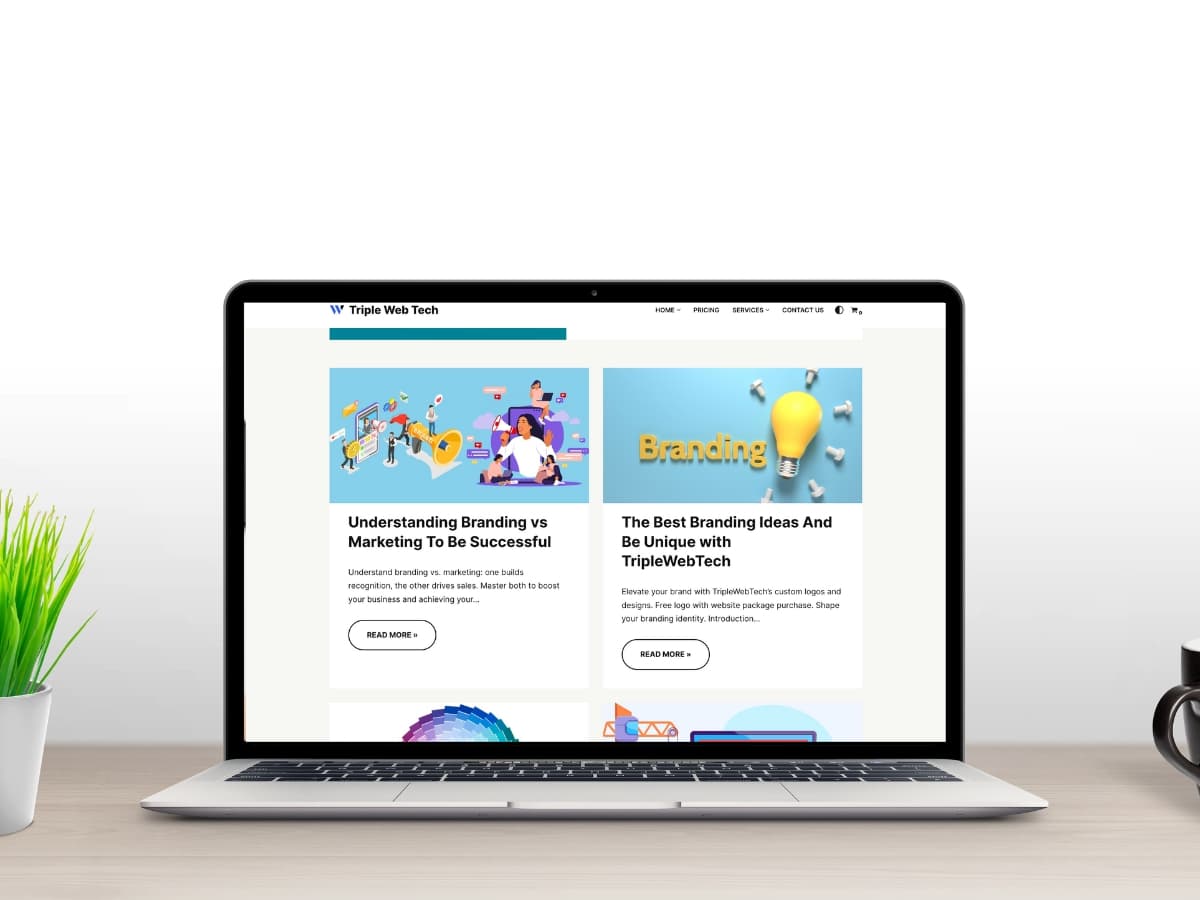TripleWebTech crafts custom SEO content like blog posts and product descriptions to enhance online presence. Innovative and customized process
Introduction
Unique content creation is the process of producing original, high-quality written or multimedia material tailored specifically for your target audience. In today’s digital landscape, creating distinctive blog post is more important than ever for businesses and organizations looking to stand out.

Generic, duplicated, or low-value content simply won’t capture attention or drive results in a crowded online space. Audiences expect informative, interesting blog posts that speaks directly to their needs and interests. By taking the time to craft blog posts that offers a unique perspective, fresh insights, or compelling storytelling, you demonstrate respect for your readers while building trust and authority around your brand.
A call to action section
A Call to action section made with Neve Custom LayoutsThe benefits of unique content creation include:
- Increased visibility and discoverability through search engines and social media
- Higher conversion rates by providing the exact information prospects are seeking
- Stronger customer relationships and loyalty by delivering consistent value
- Reduced bounce rates as visitors are engaged by the information
- Natural links and shares as audiences gravitate toward remarkable messages
With careful research, thoughtful planning, and a creative approach, just about any business or organization can produce special blog posts that attracts and retains the right audience. In a world saturated with often duplicative information, unique content creation is no longer optional – it’s an imperative.
Understand Your Audience

“Knowing your audience involves understanding others, and their perspectives, to see if they understand your words, examples, or the frames of reference you use to communicate your experiences, points, and conclusions. Ask yourself when you last had a miscommunication with someone. No doubt it was fairly recently, as it is for most people.”
Some key questions to ask:
- What is your target demographic? Age, gender, location, income level, etc.
- What are their pain points and problems they want solved?
- How do they prefer to consume information (reading articles, watching videos, listening to podcasts, etc.)?
- What information are they seeking?
- What topics excite them?
- Where do they consume content – website, social media, email, etc.?
- What are their information consumption habits?
- What motivates them to share information?
Understanding the answers to these questions will allow you to create posts specifically tailored to your audience. Speak directly to their needs and interests. The more relevant your posts, the more likely they are to engage with it. Continually gather feedback and data on your audience to refine your understanding over time.
Perform Keyword Research

Keyword research is a crucial first step when creating blog posts. It involves identifying relevant keywords and topics that you can focus your information around. This helps ensure you are creating content that resonates with your target audience and has a higher chance of ranking well in search engines.
Here are some tips for effective keyword research:
- Use keyword research tools like Google Keyword Planner, SEMrush, or Ahrefs to generate keyword ideas and analyze search volume and competition. Look for keywords with decent search volume and low-medium competition.
- Analyze your competitors’ content and the keywords they are targeting. You can use tools like Ahrefs or SEMrush to do this.
- Look at suggested search queries in Google Search Console for your site. These show actual searches people are doing that brought them to your site.
- Brainstorm relevant topics and questions around your business. Think about what users would search for.
- Use Google Autocomplete and Google Trends to get keyword suggestions.
- Include long-tail keywords (phrases with 3 or more words) as these tend to have less competition.
- Group keywords into topic clusters that make sense as the focus for a specific content piece.
- Prioritize keywords that align with your business goals – like product keywords, service keywords or those related to the top of the sales funnel.
Thorough keyword research takes some time upfront, but ensures your posts targets searches your ideal customers are actually doing. This helps drive qualified organic traffic to your site over time.
Develop a Content Strategy

“A content strategy is the planning, creation, publication, management, and governance of content. A great content strategy will attract and engage a target audience, meeting their needs while driving business goals.”
A strong strategy is key to creating unique content that resonates with your target audience. Before writing, map out the types of content you want to produce, the topics you will cover, and your publishing plan.
Types of Content
Consider creating a mix of content formats like:
- Longform articles
- List posts/roundups
- Interviews
- Infographics
- Videos
- Podcasts
Varying your content types keeps your audience engaged across different mediums.
Topics to Cover
Brainstorm topics that are:
- Relevant to your audience’s interests and pain points
- Timely and connected to current events/trends
- Unique perspectives on popular subjects
- Evergreen and useful long-term
Look at search volume and competition to identify topics with opportunity.
Publishing Plan
Develop an editorial calendar to space out your content across weeks/months. Outline:
- Content types/formats
- Specific topics
- Target publishing dates
- Authors
Consistency is key – determine the ideal publishing frequency for your resources. Leverage evergreen content in between new content launches.
Having a roadmap will help you create quality content catered to your audience while ensuring you have a steady stream of new material.
Create Compelling Headlines

Your headlines are one of the most important parts of your content. They are often the first thing readers see, and compelling headlines can grab attention and entice readers to continue.
When creating headlines, focus on crafting titles that create curiosity and interest. Use the headlines to hint at the value the reader will gain by reading more. Ask questions, highlight benefits, or use intriguing phrases to capture attention.
Some tips for writing great headlines:
- Keep headlines short, scannable, and descriptive. Summarize what the information is about.
- Use active, vivid language. Active verbs and vivid descriptors help make headlines stand out.
- Speak directly to your audience and their interests or pain points. Make the headline about them.
- Try using numbers, lists, or how-to formats to create interest. These signal the reader will get valuable takeaways.
- Use emotional triggers like humor, surprise, joy or outrage to draw readers in.
- Avoid overused clickbait tactics that don’t deliver what’s promised. Build trust with your readers.
- Craft multiple headline options and test them to see which resonates most with your target audience.
- Optimize headlines for search by including important keywords when possible.
The most compelling headlines provide readers with a reason to care. They build curiosity and excitement, while establishing trust and value. Take the time to craft headlines that engage your audience and encourage them to read more. Strong headlines are vital for content success.
Write Engaging Introductions

Your introduction is your chance to hook readers and get them interested in your content right from the start. The first 1-2 sentences are crucial for capturing attention and setting the tone for what’s to come. “Your introduction should begin with an engaging statement devised to provoke your readers’ interest.“
Some tips for writing strong introductions:
- Open with an interesting fact, statistic, or question to draw readers in. Make it surprising or counterintuitive.
- Tell a brief anecdote or story that introduces the topic in a memorable way.
- Reference current events or news to make the topic timely and relevant.
- Pose an interesting dilemma or problem that the article will address. Readers will keep reading to see the solution.
- Describe the topic in a vivid, visual way using metaphors, analogies, or imagery. This creates a strong initial impression.
- Summarize the key points or findings covered in the article. This gives readers an overview of what to expect.
- Provide an emotive, inspiring call to action if appropriate to motivate readers.
The introduction is your one chance to grab attention. Take the time to craft an opening that immediately pulls readers in and compels them to keep reading.
Provide Value Through Body Content
The body content is where you can really add value for your readers by sharing useful information, data, stories, and tips. Here are some ways to make your body content engaging and valuable:
- Share data and statistics. Back up your points with facts and figures. Data makes your information more credible. Just be sure to cite your sources.
- Use examples and case studies. Help readers understand concepts by using concrete examples and case studies. Real-world stories are more memorable than abstract ideas.
- Give step-by-step instructions. For how-to content, break down processes into clear, actionable steps. Use bullet points, numbered lists, images, and videos as needed.
- Offer expert tips and advice. Draw on your own expertise or interview experts to provide insider tips readers won’t find elsewhere. Actionable advice helps readers apply your content.
- Weave in personal anecdotes. Use short, relevant stories from your own experiences to illustrate points and connect with readers. But don’t overdo it.
- Include quotes. Relevant quotes from experts and sources you interview can add color. But don’t rely on too many quotes.
- Ask engaging questions. Asking questions related to your topic encourages readers to think more deeply about your information.
- Add images, charts, videos. Visuals make your content more engaging and easier to skim. But make sure they’re high-quality and supplement your information rather than replace text.
The key is to think about what information would be most useful and valuable for your target audience. Pack your information with helpful facts, data, advice, and real-world examples. This provides true value readers won’t find elsewhere.
Include Multimedia

Adding visual elements to your content can make it more engaging and help convey information clearly. Here are some tips for including multimedia:
- Images: Relevant photos and graphics grab attention and break up blocks of text. Make sure any images are high-quality, credited properly, and add value.
- Infographics: Displaying data visually through charts, graphs, and diagrams can simplify complex information. Infographics are highly shareable across social media.
- Videos: A short, informative video can communicate key ideas efficiently. Embed videos seamlessly into your information.
- Audio: Podcasts, music clips, or interviews let users listen while multitasking. Provide transcripts for accessibility.
- Sliders/Carousels: Use sliders and carousels to feature multiple visuals in a compact space. Ensure they function smoothly on all devices.
- Interactive Content: Quizzes, calculators, and other interactive elements encourage engagement. Make them user-friendly with clear instructions.
A mix of multimedia makes the information more dynamic. But use discretion – choose multimedia deliberately, not just for decoration. Ensure accessibility, optimize load times, and tie visuals directly into your goals. Integrating the right visual elements at the right moments can elevate any post or page.
Check for Errors
It’s crucial to thoroughly proofread your content before publishing to check for any errors that may undermine your credibility or distract readers. Set your draft aside for at least a few hours before proofreading with a fresh perspective. Read slowly and carefully, keeping an eye out for:
- Typos – Double-check proper names or uncommon words that spellcheck may miss. Read backwards word-by-word to spot typos.
- Grammar mistakes – Check for issues like subject-verb agreement, run-on sentences, missing commas, etc. Read sentences aloud to catch awkward phrasing.
- Factual inaccuracies – Verify any statistics or facts cited against original sources. Double check proper names and dates.
- Broken formatting – Scan for inconsistent heading sizes/styles, alignment issues, missing alt text, etc.
- Plagiarism – If you’ve quoted or paraphrased sources, ensure they are properly attributed. Use online tools to detect any accidental copied information.
Proper formatting is also key for readability and accessibility. Use heading styles, lists, and whitespace strategically to make your content easy to digest. Careful proofreading shows readers your commitment to producing quality content worth their time.
Promote Your Content
Promoting your content is crucial to reaching your target audience and driving engagement. Here are some effective tactics:
Leverage Social Media
- Share your content across your business’s social media channels. Post links on platforms like Facebook, Twitter, LinkedIn, and Pinterest.
- Engage followers by posing questions, polls, quizzes, and calls-to-action related to your content to spark discussion. Respond to comments and feedback.
- Use relevant hashtags so your content can be discovered by people outside your existing followers.
- Run social media ads to increase visibility. Consider promoted posts, social media influencer partnerships, and social media takeovers.
Email Marketing
- Send emails to your subscriber list highlighting your new content. Use catchy subject lines that will grab attention.
- Dedicate a section of your regular newsletter to feature your latest content pieces.
- Send targeted emails when you publish content you think specific segments of your audience will be interested in.
Form Strategic Partnerships
- Ask industry partners, influencers, bloggers, and media contacts to share or reference your content if it’s relevant to their audience.
- Seek co-promotion opportunities by collaborating with complementary brands to co-create and cross-promote.
- Guest post on industry websites and blogs to expand your reach. Include links back to your content.
- Pitch your content to media outlets and journalists who cover related topics. Become a thought leader they seek out.
Conclusion
In today’s content-saturated world, standing out requires a strategic approach. By creating unique content that resonates with your target audience, you can attract new followers, build brand loyalty, and ultimately achieve your business goals.
This guide has provided a comprehensive roadmap for crafting compelling content. Remember, the key lies in understanding your audience, tailoring your content to their needs, and delivering exceptional value.
Here’s a quick recap of the essential steps:
- Know your audience: Conduct thorough research to understand their pain points, interests, and preferred formats.
- Perform Keyword Research: Performing keyword research involves finding the words and phrases people search for to create post that aligns with their needs.
- Develop a content strategy: Plan your content types, topics, and publishing schedule to ensure consistent value delivery.
- Craft captivating headlines: Intrigue readers and motivate them to delve deeper with clear, engaging headlines.
- Write compelling introductions: Hook readers from the start with a strong opening that sets the tone for the piece.
- Deliver valuable content: Share insightful information, data, and actionable advice that empowers your audience.
- Incorporate multimedia: Integrate relevant visuals like images, infographics, or videos to enhance comprehension and engagement.
- Proofread meticulously: Ensure flawless content by eliminating errors and typos for a professional presentation.
- Promote strategically: Leverage social media, email marketing, partnerships, and media outreach to amplify your content’s reach.
By following these steps and continuously refining your approach, you can transform your content creation into a powerful tool for driving engagement and achieving long-term success.
Embrace the power of unique content and watch your audience take notice!